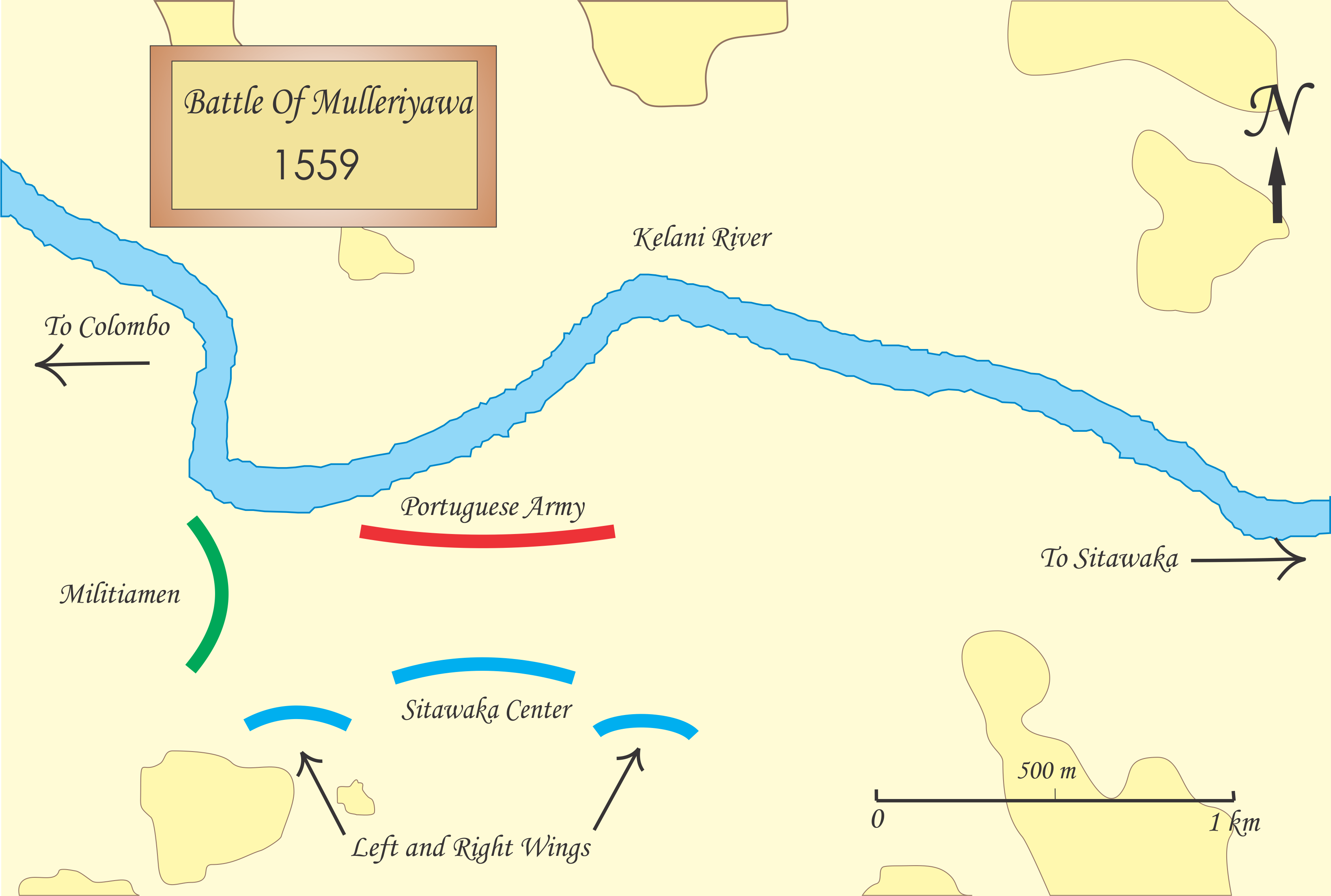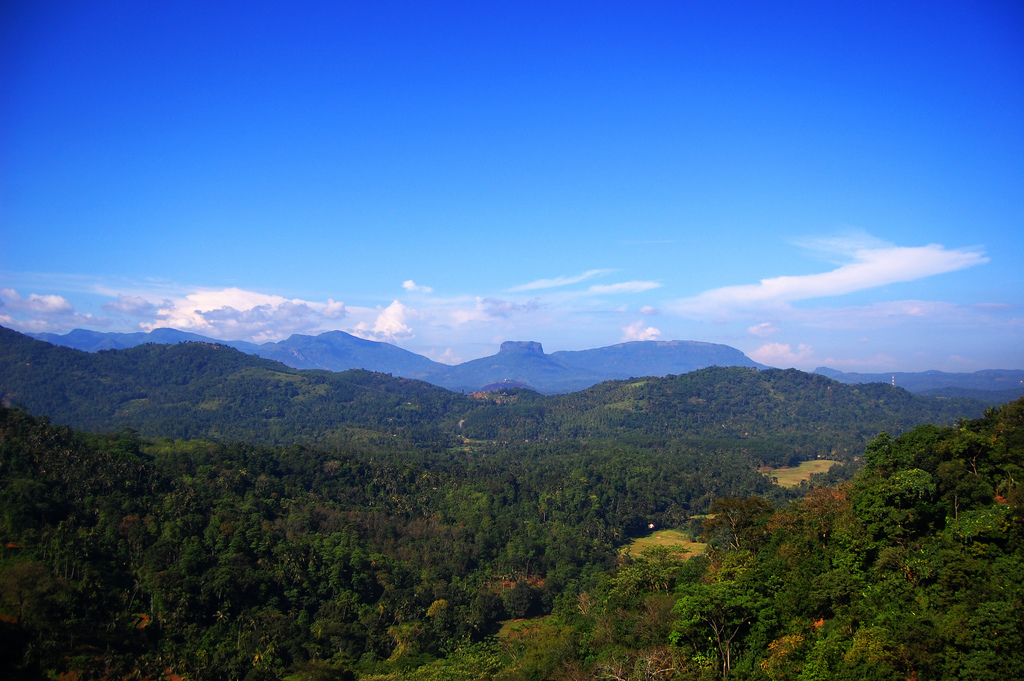|
Battle Of Mulleriyawa
The Battle of Mulleriyawa ( si, මුල්ලේරියාව සටන) in 1559 was part of the Sinhalese–Portuguese War. It was one of the most decisive battles in Sri Lankan history and considered as the worst defeat of Portuguese during that period. According to local chronicles the marshlands of Mulleriyawa turned red with blood after the annihilation of the Portuguese. With this victory Sitawaka emerged as a military power which able to challenge the Portuguese expansion. Background Portuguese arrived in Sri Lanka in 1505 and established trade relations with kingdom of Kotte. They erected a fortress in Colombo and garrisoned it. In 1521, King Vijayabahu VI's three sons mutinied against their father. They ousted him, had him assassinated, and divided the kingdom among themselves, leading to the events which known as “ Spoiling of Vijayabahu” (Vijayaba Kollaya). The eldest son, Buvanekabahu VII received Kotte with the sea board and ruled with the title of emper ... [...More Info...] [...Related Items...] OR: [Wikipedia] [Google] [Baidu] |
Rajasimha I Of Sri Lanka
Rajasinghe I ( Sinhala:පළමුවන රාජසිංහ) was a king of Sitawaka, known for his patriotism and fight against the Portuguese invasion of Sri Lanka. Born as Tikiri Bandara to King Mayadunne, he received the name "Rajasinha" (meaning ''the Lion King'') after the fierce Battle of Mulleriyawa. Ascent to throne Generally, the recorded period of Rajasinha's reign starts from 1581 to 1592. However, as per Portuguese navigator De Queros, Mayadunne had turned the kingdom over to Rajasinha in 1578 before his death in 1581. There are various narratives surrounding Rajasinha's role in his father's death. As per Thibbotuwawe Buddharakhitha's Mahawamsa(Chapter 4) written during the reign of Kirti Sri Rajasinha of Kandy, Rajasinha killed him. Minor Rajawaliya wrote that his patricide was considered an irreversible anantharya karma by Buddhist monks, so conflicts arose between him and the monks. As a result, he followed an anti-Buddhist line. However, others believe t ... [...More Info...] [...Related Items...] OR: [Wikipedia] [Google] [Baidu] |
Portugal
Portugal, officially the Portuguese Republic ( pt, República Portuguesa, links=yes ), is a country whose mainland is located on the Iberian Peninsula of Southwestern Europe, and whose territory also includes the Atlantic archipelagos of the Azores and Madeira. It features the westernmost point in continental Europe, and its Iberian portion is bordered to the west and south by the Atlantic Ocean and to the north and east by Spain, the sole country to have a land border with Portugal. Its two archipelagos form two autonomous regions with their own regional governments. Lisbon is the capital and largest city by population. Portugal is the oldest continuously existing nation state on the Iberian Peninsula and one of the oldest in Europe, its territory having been continuously settled, invaded and fought over since prehistoric times. It was inhabited by pre-Celtic and Celtic peoples who had contact with Phoenicians and Ancient Greek traders, it was ruled by the Ro ... [...More Info...] [...Related Items...] OR: [Wikipedia] [Google] [Baidu] |
Malaria
Malaria is a mosquito-borne infectious disease that affects humans and other animals. Malaria causes symptoms that typically include fever, tiredness, vomiting, and headaches. In severe cases, it can cause jaundice, seizures, coma, or death. Symptoms usually begin ten to fifteen days after being bitten by an infected mosquito. If not properly treated, people may have recurrences of the disease months later. In those who have recently survived an infection, reinfection usually causes milder symptoms. This partial resistance disappears over months to years if the person has no continuing exposure to malaria. Malaria is caused by single-celled microorganisms of the ''Plasmodium'' group. It is spread exclusively through bites of infected ''Anopheles'' mosquitoes. The mosquito bite introduces the parasites from the mosquito's saliva into a person's blood. The parasites travel to the liver where they mature and reproduce. Five species of ''Plasmodium'' can infect and be spread by h ... [...More Info...] [...Related Items...] OR: [Wikipedia] [Google] [Baidu] |
Afonso Pereira De Lacerda
Afonso Pereira de Lacerda was the fifth captain-major of Portuguese Ceylon. Lacerda was appointed in 1555 under Sebastian of Portugal Sebastian ( pt, Sebastião I ; 20 January 1554 – 4 August 1578) was King of Portugal from 11 June 1557 to 4 August 1578 and the penultimate Portuguese monarch of the House of Aviz. He was the son of João Manuel, Prince of Portugal, and hi .... He served as captain-major until 1559. He was succeeded by Jorge de Meneses Baroche. References {{DEFAULTSORT:Lacerda, Afonso Pereira de Captain-majors of Ceilão 16th-century Portuguese people ... [...More Info...] [...Related Items...] OR: [Wikipedia] [Google] [Baidu] |
Mulleriyawa Battle Site On Sri Lanka Map
Mulleriyawa () is a city in the Western Province of Sri Lanka. It has a population of 33,540. See also * Battle of Mulleriyawa * List of towns in Western Province, Sri Lanka Western Province is a province of Sri Lanka, containing the Colombo District, Gampaha District, and Kalutara District. The following is a list of settlements in the province. __NOTOC__ A Aboyne, Adikarigoda, Adikarimulla, Adikkandiya, A ... References Populated places in Western Province, Sri Lanka {{WesternLK-geo-stub ... [...More Info...] [...Related Items...] OR: [Wikipedia] [Google] [Baidu] |
Siege Of Kotte (1557-1558)
A siege is a military blockade of a city, or fortress, with the intent of conquering by attrition, or a well-prepared assault. This derives from la, sedere, lit=to sit. Siege warfare is a form of constant, low-intensity conflict characterized by one party holding a strong, static, defensive position. Consequently, an opportunity for negotiation between combatants is common, as proximity and fluctuating advantage can encourage diplomacy. The art of conducting and resisting sieges is called siege warfare, siegecraft, or poliorcetics. A siege occurs when an attacker encounters a city or fortress that cannot be easily taken by a quick assault, and which refuses to surrender. Sieges involve surrounding the target to block the provision of supplies and the reinforcement or escape of troops (a tactic known as " investment"). This is typically coupled with attempts to reduce the fortifications by means of siege engines, artillery bombardment, mining (also known as sapping), or the us ... [...More Info...] [...Related Items...] OR: [Wikipedia] [Google] [Baidu] |
Dharmapala Of Sri Lanka
Dharmapala or Dom João Dharmapala Peria Bandara (1541 – 27 May 1597) was last king of the Kingdom of Kotte, in present-day Sri Lanka, from 1551 until 27 May 1597. He is also known as Dom João Dharmapala, the first Christian king in Sri Lankan history. He is widely known as the last true King and ruler of the capital city Kotte; under Portuguese military occupation, he attempted to reorganise his military and pursue a treaty with the Portuguese to save the Sinhalese Kingdom. Birth Dom João Dharmapala (Don John Dharmapala) was born as the eldest child of Weediye Bandara, a Prince from Madampe and his wife Samudra Devi, daughter of King Bhuvanekabãhu VII the King of Kotte. His exact date of birth is unknown, but the year is commonly regarded as 1541. A golden statue was sent to Portugal to be crowned by the Portuguese. It was sent by his predecessor King Bhuvanekabahu VII. Dharmapala's descendants include the Goonewardene & Rodrigo families of Kalutara who are of Karava c ... [...More Info...] [...Related Items...] OR: [Wikipedia] [Google] [Baidu] |
Bhuvanekabahu VII Of Sri Lanka
Bhuvanaikabahu VII (1468 – 29 December 1550) was King of Kotte in the sixteenth century, who ruled from 1521 to 1551. He was the eldest son of Vijayabahu VII of Kotte, whom he succeeded, and his chief queen Anula Kahatuda. He was born in 1468 and his brothers were Mayadunne of Sitawaka and Rayigam Bandara. After his father married a second time, his new queen brought a son from another relationship called Deva Rajasinghe, who the king intended to pass on the crown to, and Bhuvanaikabahu and his two brothers responded by fleeing the kingdom, and on their return they had an army given by the King of Kandy. Bhuvanaikabahu VII was succeeded by his grandson Dharmapala. Reign After Mayadunne successfully led the men of Jayavira, the king of Kandy, against his father, the Kingdom of Kotte was divided into three among Vijaya Bahu VII's legitimate sons in 1521: Bhuvanaikabahu was crowned the King of Kotte as Bhuvanaikabahu VII, Sitawaka was given to Mayadunne of Sitawaka and Ray ... [...More Info...] [...Related Items...] OR: [Wikipedia] [Google] [Baidu] |
Mayadunne Of Sitawaka
Mayadunne ( si, මායාදුන්නේ) (1501–1581) was the King of Sitawaka, ruled the kingdom between 1521 and 1581. Mayadunne was a fierce opponent of the Portuguese, who had arrived on the island in 1505. He devoted his early life to oust his father and his whole life afterwards attempting to oust his brother Bhuvanekabahu VII, the king of Kotte and thereby preserve the independence of the island, which was being undermined by the Portuguese intrigue. He constantly invaded the territory of Bhuvanekabahu of Kotte. Early life Mayadunne was born in 1501 in Kotte of the Kingdom of Kotte. He was the son of Vijayabahu VII who reigned as king from 1509 to 1521. Mayadunne was the youngest child born to Vijaya Bahu VII and his main Queen. He had two full brothers, Bhuvanekabahu and Raigama Bandara. Bhuvanekabahu who was also king of Kotte from 1521 to 1551. Wijayaba Kollaya In 1521 together with his two full brothers Bhuvanekabahu and Raigama Bandara, who were born ... [...More Info...] [...Related Items...] OR: [Wikipedia] [Google] [Baidu] |
Kingdom Of Sitawaka
The Kingdom of Sitawaka ( si, සීතාවක, ta, சீீீதாவாக்கை இராசதானி) was a kingdom located in south-central Sri Lanka. It emerged from the division of the Kingdom of Kotte following the Spoiling of Vijayabahu in 1521. Over the course of the next seventy years it came to dominate much of the island. Sitawaka also offered fierce resistance to the Portuguese, who had arrived on the island in 1505. Despite its military successes, Sitawaka remained unstable, having to contend with repeated uprisings in its restive Kandyan territories, as well as a wide-ranging and often devastating conflict with the Portuguese. Sitawaka disintegrated soon after the death of its last king Rajasimha I in 1593. History Foundation The Kingdom of Kotte had been the major power in western Sri Lanka since its foundation in the early 15th century; under Parakaramabahu VI, the polity has been the last to unite the entirety of the island of Sri Lanka under ... [...More Info...] [...Related Items...] OR: [Wikipedia] [Google] [Baidu] |
Raigama Bandara
Raigama Bandara also known as Pararajasinghe was the son of Vijayabahu VII (1521) and brother of Mayadunne and Buvanekabahu VI. When Kingdom of Kotte The Kingdom of Kotte ( si, කෝට්ටේ රාජධානිය, Kottay Rajadhaniya), named after its capital, Sri Jayawardenepura Kotte, Kotte, was a Sinhala kingdom, Sinhalese kingdom that flourished in Sri Lanka during the 15th cent ... was divided due to the incident known as " Wijayaba Kollaya", which resulted in the assassination of king Vijayabahu, Pararajasinghe became the ruler of Raigama. Raigam Bandara is known as a good ruler who upheld the economy of the Raigama. However, after a battle with the Kingdom of Kotte the family of Raigam Bandara had fled to Matara as a result of miscommunication. The fleeing of the family was followed by the downfall of the ruler himself. The only descendants of the king still live bearing the name of "Mohotti" in Matara and in North Central province. Crisis of the Sixteen ... [...More Info...] [...Related Items...] OR: [Wikipedia] [Google] [Baidu] |
.png)



